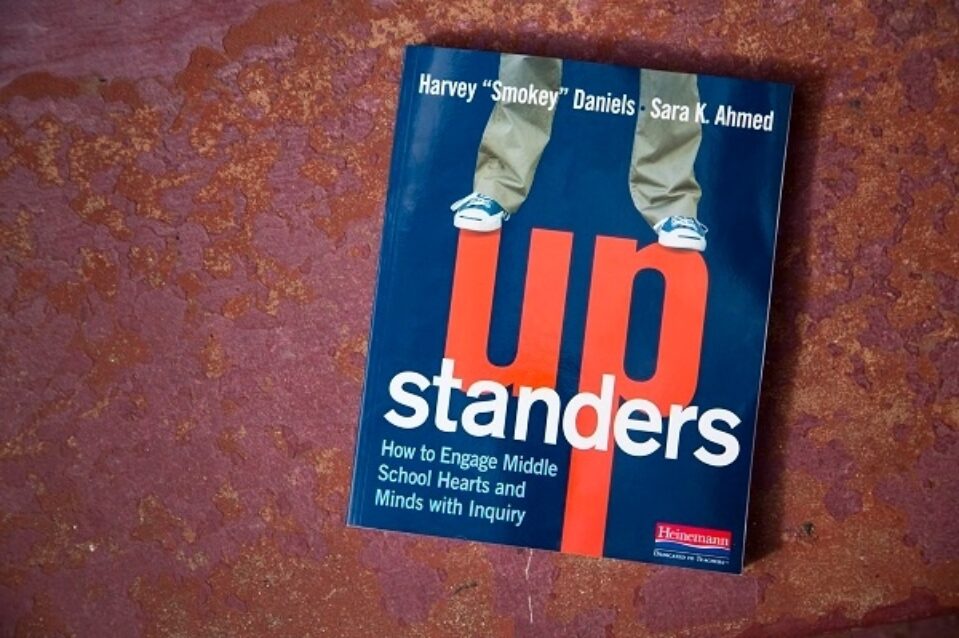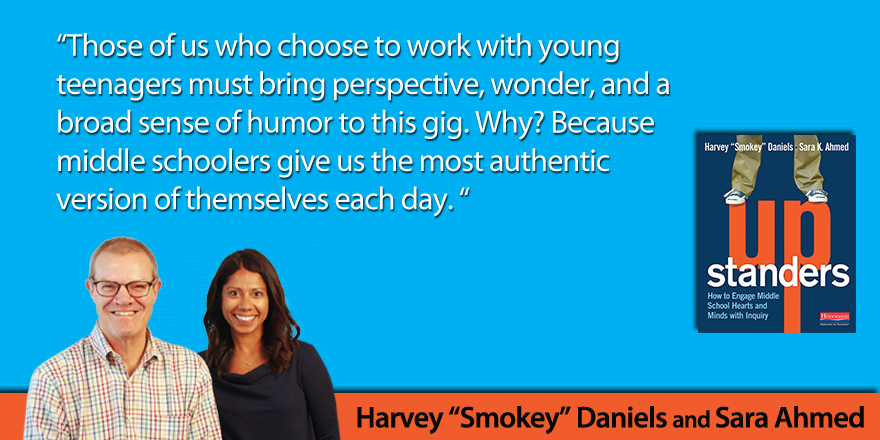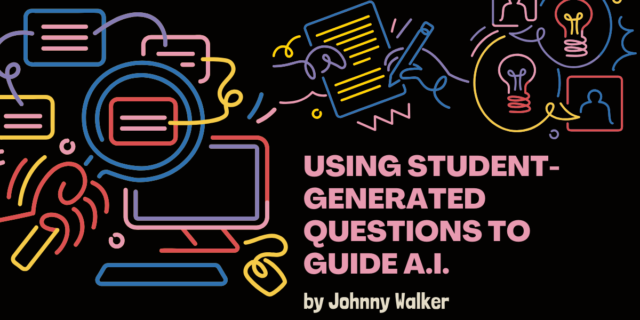
Upstanders: How to Engage Middle School Hearts and Minds with Inquiry is a new book from Harvey “Smokey” Daniels (@smokeylit) and Sara Ahmed (@SaraKAhmed). Smokey is your guide to Sara’s classroom. Together they’ll show you exactly how Sara uses inquiry to turn required curricular topics into questions so fascinating that young adolescents can’t resist investigating them. In our Upstanders blog series, Sara and Smokey will highlight topics in the book related to middle school and helping kids go from bystanders to Upstanders. In this blog, Sara gives an example of how to engage students to solve a problem. This blog is a selection written for the book.
Working with (Not Against) Adolescent Development
Written by Harvey "Smokey" Daniels & Sara K. Ahmed
Unpaired shoes are strewn about the room. Backpacks are open with folders sprawling out onto the floor. Hoodies are thrown over backs of chairs haphazardly, cascading down to the floor. Magazines and novels are everywhere—in the hands of kids, on their bellies, under their feet, under the desks. Water bottles lie on their sides, condensation soaking homework. The kids are at peace, little angels reading independently in their happy place. I am boiling over with frustration after I trip over my third and final backpack.
Rather than interrupting their Zone, I take some deep breaths. I have already tried to institute the rule that they need to line their shoes up along the wall and their backpacks need to be under their desks. That worked for four days. There has to be a solution to this, I think. I am very open with communicating to them when I am frustrated and invite them to do the same; but when I have reached my limit, it is not the time.
The next day, after our soft start, I bring the kids to the rug for a chat.
“Guys, I want you to look at the room for a second and talk to me about why I might be frustrated.”
They look around and there are some blank stares from kids who accept this kind of mess as normal. A few of the kids who actively try to keep their space clean notice that there is stuff everywhere. They point out the shoes, the bags, and the magazines that are perpetually in the wrong place.
I affirm their keen observations and then explain to them that I am tripping over things, they are tripping over things, and that when guests come to our classroom, I have to warn them of the obstacle course they face.
“I need to let you guys in on a little secret.” I pull up a colorful map of the human brain on the doc camera and hand out a paper copy to each kid. “Your brain is part superhero power and part kryptonite.” (We read a Superman book at the beginning of the year.) “It is pretty awesome because you have something that I and most adults don’t have anymore: you have an amazing capacity for strong emotions because this part of your brain, the amygdala, is more dominant than the amygdala in adults’ brains. This enables you to have amazing emotional responses, and it even helps you really understand the characters and people in history that we read about. It may be why you feel extra sensitive to people and events sometimes, but makes for you being a great person too because you are so caring. It’s awesome!”

Crickets... I suddenly forget why I am explaining any of this to them. It would be much easier to just yell at them.
“The kryptonite part, though, is your frontal cortex, this part on the diagram, and it is still developing. This is the part of your brain that allows you to slow down and think about your actions, like where you are putting things, and be a little more aware of your space.
“I posted a link to our Edmodo page about these parts of the brain. I am going to give you some time back at your desks to research the amygdala and the cortex and figure out what they mean to you. On the brain maps you just labeled, write down two or three characteristics of each part, like a caption right next to it. We will meet back here in a few minutes.”
A few minutes later, back on the rug, we share our findings and fill out our brains together. They are pretty excited to have more excuses as to why they are tripping over their own two feet, why there is a trail of debris and equipment behind them everywhere they go, and why they lose their things every second.
“So, my initial frustration with you guys has been tamed by this new knowledge we all have, but this just means we all need to work a little harder to keep this a safe space for everyone. We have to work double hard to be aware of our things and how we are actually sharing the classroom with others in our community. We want to be our best selves all the time, so we all need to pitch in with this. Can you try to override your amygdalas a little?”
There’s a cheerful chorus of, “Sure, Ms. Ahmed,” and on we go. My expectations are realistic—I know progress will be measurable but modest.
Click here to see more of Upstanders
♦ ♦ ♦ ♦
 Sara K. Ahmed has taught in urban, suburban, public, independent, and international schools. Harvey "Smokey" Daniels has been a city and suburban classroom teacher and college professor, and now works as a national consultant and author on literacy education.
Sara K. Ahmed has taught in urban, suburban, public, independent, and international schools. Harvey "Smokey" Daniels has been a city and suburban classroom teacher and college professor, and now works as a national consultant and author on literacy education.


